Location :
Who built the temple and when
This Divine old temple was consecrated on Thursday, 19th November 1801. According to the Hindu Calendar it falls on Kartik Shudha Chaturdashi, Shake 1723 in “Durmukh Sanvatsar”. The Siddivianayak mandir is on the corner of Kakasaheb Gadgil Marg and S.K.Bole Marg in Prabhadevi, which is facing heavy vehicular traffic. It was built by a professional contractor, Late Mr.Laxman Vithu Patil according to the financial support and instructions of Late Mrs.Deubai Patil, who was a rich lady of Agri Samaj from Matunga. Since the days it is been constructed the idol has been kept as it is and the temple structure has been built into a unique six-storeyed construction, which almost touches the sky. The top of the temple is clad with a golden dome, which dazzles brilliantly in the sun.
Significance of the temple
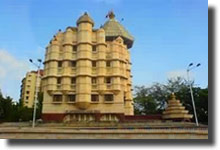
The idea of the construction of the temple was struck to Late Deubai during the prayer time, as she was humbly requesting Lord Ganesh and said, “Although I cannot have a child, let other ladies who are childless get the pleasure of child on visiting the temple and praying you”.
As one looks at successful subsequent history of the temple, it appears like the Lord Ganesh nodded to this humble request and pious thoughts and deeds of Late Deubai Patil. It is, therefore, this Siddhivinayak is famous for it and known as “Navasacha Ganapati” or “Navasala Pavanara Ganapati”. I n Marathi it means that Ganapati bestows whenever the devotees humbly and genuinely prayed a wish.
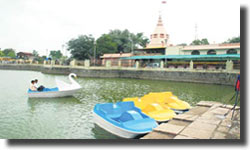
On the forehead of deity is an eye, which almost looks like the third eye of Lord Shiva. On both sides of the Lord Ganesh idol, are placed one idol each of Riddhi and Siddhi goddesses who are appearing like peeping out of the Ganesh idol from behind. Because of these two deities along with Lord Ganesh, this temple is known as the Siddhivinayak Ganapati Temple.
The legend goes that around 125 years ago, Shri Akkalkot Swami Samarth's great disciple, Late Ramakrishna Jambhekar Maharaj, who was also an ardent devotee of Lord Ganesh and Gayatri Mantra was blessed with Assyssinian (Siddhi). One day Swami Samarth asked Shri Jambhekar to bring divine idols. Out of the idols, except two idols, Swami Samarth told to bury in the front courtyard of the house of Swami Samarth's another disciple Shri Cholappa, where Swami Samarth used to temporarily reside.
Shri Jambhekar was also told to construct remaining two idols in front of Lord Ganesh that he usually worshipped. During his attendance with Swami Samarth, Shri Jambhekar foretolded that a Mandaar tree would grow on the place after 21 years; Swayambhu (Swayambhu) Ganesh would appear on the sacred place. From that time onwards people's devotion grew in leaps and beyond.
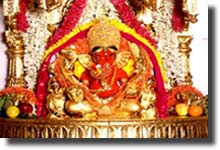
From the available information and records, the land of the famous temple complex today is around 2550 sq.mtrs. There was a lake towards eastern and southern side of temple admeasuring approx. 30 x 40 sq.mtrs. This lake was built by Nardulla in early 19th century, to overcome the scarcity of the water, faced by the area. The lake was, later on, filled up, and now it is playground and a part of Kakasaheb Gadgil Marg.
There is also a rest house near the temple which is sought of Dharmashala and a pair of beautiful 3.6 in high, stone masonry “Deepmalas”. There is also a dwelling unit for the owner of this complex. The devotees in large numbers started visiting the temple only after 1952 and the long standing queues were seen from 1965 onwards.
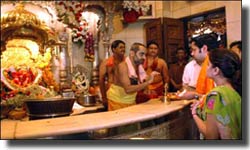
Earlier, the Siddhivinayak temple was a very much small construction highlighting the black idol of Shree Siddhivinayak, carved out of stone. It was only two and half feet wide then. The most remarkable feature of this idol of Lord Ganesh is that, His trunk is tilted to the right side. The deity has four hands , which is why it is also called Chaturbhuj. The four hands contain a lotus, a small axe, holy beads and a bowl full of Modaks, a sweet considered to be a favorite with Shree Siddhivinayak. On both the sides of the deity are Siddi and Riddhi, two Goddesses standing for holiness, fulfillment, wealth and prosperity. The Siddhivinayak has an eye engraved on his forehead.
Time to visit
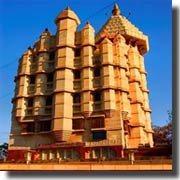
The Best day to visit the temple is Tuesday and at Ganesh chathurti. The temple's opening Schedule daily begins at 4 a.m. The devotees visit timings are from 11.00 a.m - 12.00 Noon and the Pooja Schedule is 4.30 a.m. to 5.00 a.m & 8.30 p.m. to 9.15 p.m.
Rules and Rituals of the temples
- Kakad Aarti - done in the early morning prayer: at 5.30 a.m. to 6.00 a.m.
- Shree Darshan - morning at 6.00 a.m. to afternoon 12.15 p.m.
- Naivedhya - afternoon at 12.15 p.m. to afternoon 12.30 p.m.
- Shree Darshan - afternoon at 12.30 p.m. to evening 7.20 p.m.
- Aarti -Evening - The evening Prayer : 7.30 p.m. to 8.00 p.m
- Shree Darshan - at 8.00 p.m. to 9.50 p.m
- Shejaarti - The last Aarti of the day before bedtime : night 9.50 p. m. (The temple doors remain closed after shejaarti)
- The Temple is fully closed till next morning after 'Shejaarti.
Other places to visit
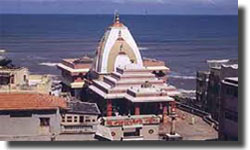
Accommodation facilities
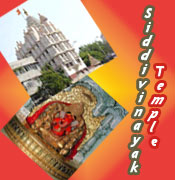 |
Nearby tourist places to Siddivinayak Temple
Pune Mumbai |
As Mumbai is the financial capital city of India one can find decent accommodation facilities in very nearby places of pilgrimages. There is combination of hotels, dharmsalas and lodges for the devotees who visit the temple. |
How to Reach the Temple
- Through Airways- the city of Mumbai is a most important international doorway to India with international flights from major countries of the world. Air India and many other global air carriers operate regular flights to and via the city. Indian Airlines connects Mumbai with nearly all tourist destinations all over India. Private sector airlines also offer air-link to many key centres of the country. The Mumbai airport has two wings which are like Chhatrapati Shivaji international Airport and Santacruz domestic airport.
- Through Railways -Mumbai city is the control center of the Central and Western Railways. Usual train services unite it with all main cities like Ahmedabad, Aurangabad, Bangalore, Bhopal, Kolkata, Delhi, Goa, Hyderabad, Jaipur, Chennai, Nagpur and Thiruvananthapuram. You can travel to Mumbai from any part of the country by direct train service.
- Through Road ways- there are good motorable roads with all major tourist centres connecting Mumbai. National Highways across the length and breadth of the country are great ways to go for the self-drive decision and head to Mumbai.



